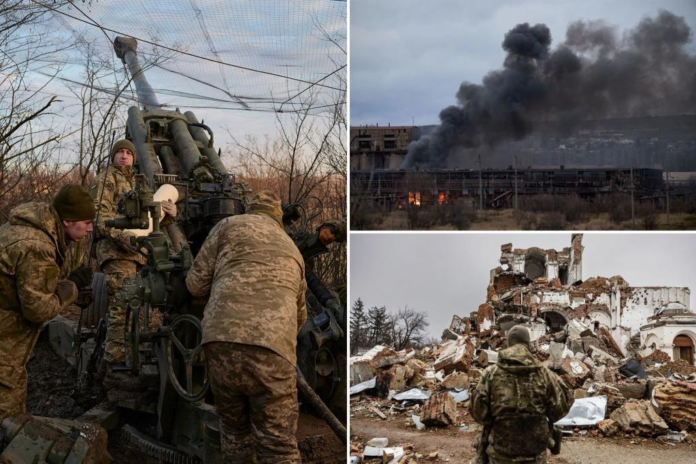As 2022 comes to the end, there is only one possible end to the war in Ukraine: Russia’s defeat, its withdrawal and its regime’s acceptance of Ukraine as a sovereign, self-governing nation. Although we are closer to that outcome than at any point since the beginning of the war, neither the Biden administration nor our European allies are doing enough to get us — and the Ukrainians — across the finish line.
Russia’s main offensive in the Donetsk region, aimed at capturing the city of Bakhmut, appears to have stalled due to the heavy losses suffered both by the Russian military and the Wagner Group’s mercenaries.
Russians are unlikely to succeed in launching new offensives elsewhere on the battlefield in, say, Luhansk or Zaporizhzhia. Unsurprisingly, their military impotence is being translated into deliberate attacks against civilians and civilian infrastructure using drones and missiles.
The coming weeks are not without risks for Ukraine, especially as the new manpower built up during Russia’s “partial mobilization” comes online. The Kremlin is also pressuring Alexander Lukashenko’s regime in Belarus to join the war effort more explicitly. At a minimum, it is conceivable that Belarus will serve, once again, as a launchpad for a new offensive aimed at taking Kyiv and decapitating Ukraine’s government.
Fortunately, such efforts are bound to fail, notwithstanding Ukraine’s heavy losses during the conflict. As President Vladimir Putin pushes more Russians into the meat grinder and tries to demoralize Ukrainians through drone and missile terrorism, the human toll is bound to increase, but Ukraine’s resolve and military competence are unlikely to flail.
A building on fire after a Russian missile strike in Kostiantynivka, Ukraine on Dec. 28, 2022. Photo by Pierre Crom/Getty Images
Alas, there is little indication of the Kremlin’s adjusting or reevaluating its maximalist war aims. In a recent public appearance, Russian Foreign Minister Sergei Lavrov continued to talk about Russia’s proposals for the “demilitarization and denazification” of Ukraine — the regime’s code word for a change of Ukraine’s government and its complete subjugation to Russia.
It is that attitude — and not Western aid to Ukraine or absence of our diplomatic outreach to Putin — that is the main barrier to peace.
The main lesson from the sham “Minsk process” that preceded the invasion is that there can be no lasting peace settlement if the Kremlin continues to act in bad faith. A deal with a regime that seeks “demilitarization and denazification” of its neighbor amounts to only a temporary cease-fire, affording Russia the opportunity to rebuild its military, rearm and attack again at a time of its choosing.
A Ukrainian soldier in front of a monastery destroyed in a Russian strike in Dolyna on December 26, 2022. Photo by SAMEER AL-DOUMY/AFP via Getty Images
The Kremlin’s mindset will not be changed by reasoned arguments. Only a decisive, embarrassing defeat on the battlefield will do the trick.
And let us be clear: changing that mindset is not peripheral to US interests, as some suggest. It is the key to a world in which America’s job would be easier than it would be if Putin were to claim anything resembling a win in Ukraine.
To think otherwise and assume that dealing with potential consequences is easier than nipping bad behavior in the bud is not a sign of “realism.” It is a symptom of shortsightedness and ignorance about history.
After all, a world in which Russia annexes territory or exercises veto power over the politics of its neighbors is a world in which our Eastern European treaty allies are under direct threat from the Kremlin. It becomes a world in which China is emboldened to annex territory or exercise veto power over the politics of Taiwan, Vietnam or South Korea. Countless lesser powers across the globe would have good reasons to assume that their own acts of aggression would go unpunished, too.
Nobody is giving Ukrainians a blank check. Giving them more Patriot batteries than the current delivery and supplying them with needed ammunition to make their skies safe from Russian terrorism is not a big ask. Neither would it be a massive sacrifice for the United States to provide Ukrainian forces with M1 Abrams tanks — which the Marine Corps has been trying to get rid of — or to backstop air forces of our Eastern European allies eager to send their aging Soviet-era MiG fleets to Ukraine.
Russia’s war against Ukraine is horrifying and nobody wants it to go on for another year. But peace can only be achieved if Russia loses. Anything short of that outcome, and especially Western attempts at bargaining with Putin, guarantee that the war will go on, not only throughout 2023 but for years to come.
Dalibor Rohac is a senior fellow at the American Enterprise Institute in Washington, DC. Twitter: @DaliborRohac.



